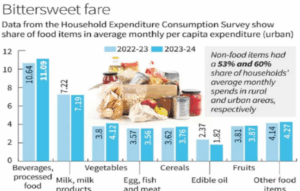
Why in News?
World Dugong Day was observed to highlight the urgent need for conservation of dugongs. India reaffirmed its commitment to protecting critical habitats like the Palk Bay and Gulf of Mannar, where dugong populations are vulnerable.
About Dugongs:
What It Is?
Dugongs (Dugong dugon) are large, herbivorous marine mammals commonly known as “sea cows.” They are the only surviving species in the Dugongidae family and are closely related to manatees.
Habitat in India:
Dugongs inhabit warm, shallow coastal waters, mainly in: 
- Gulf of Mannar
- Palk Bay
- Gulf of Kutch
- Andaman & Nicobar Islands
IUCN Status:
- Global: Vulnerable
- India: Regionally Endangered
- Legal Protection: Listed as a Schedule I species under the Wildlife (Protection) Act, 1972, granting the highest level of legal protection in India.
Features of Dugongs?
Physical Characteristics:
- Body Shape: Torpedo-shaped body with flipper-like forelimbs and no dorsal fin, enabling streamlined swimming.
- Size: Can grow up to 3 metres in length and weigh around 300 kg.
- Lifespan: Can live up to 70 years in the wild.
Biological Traits of Dugongs:
Diet:
Dugongs are herbivores and feed primarily on seagrass, consuming around 20–30 kg daily.
Teeth:
Dugongs have regenerating teeth throughout life due to the constant wear caused by abrasive seagrass.
Reproductive Traits:
- Maturity: They reach reproductive maturity at approximately 9–10 years of age.
- Birth Cycle: Dugongs give birth once every 3–5 years, resulting in slow reproductive rates.
- Population Growth: Their population grows at a maximum rate of about 5% per year.
Social Behaviour:
- Grouping: Generally solitary or found in mother-calf pairs.
- Habitat Preference: Unlike manatees, dugongs live strictly in marine environments and typically avoid human interaction.
Ecological Importance of Dugongs:
- “Gardeners of the Sea”: Dugongs help maintain healthy seagrass beds by grazing, which promotes regrowth and prevents overgrowth.
- Biodiversity Support: Their presence nurtures fish nurseries, supporting marine biodiversity.
- Climate Role: Dugongs aid in carbon sequestration through seagrass health and contribute to coastal ecosystem stability.




